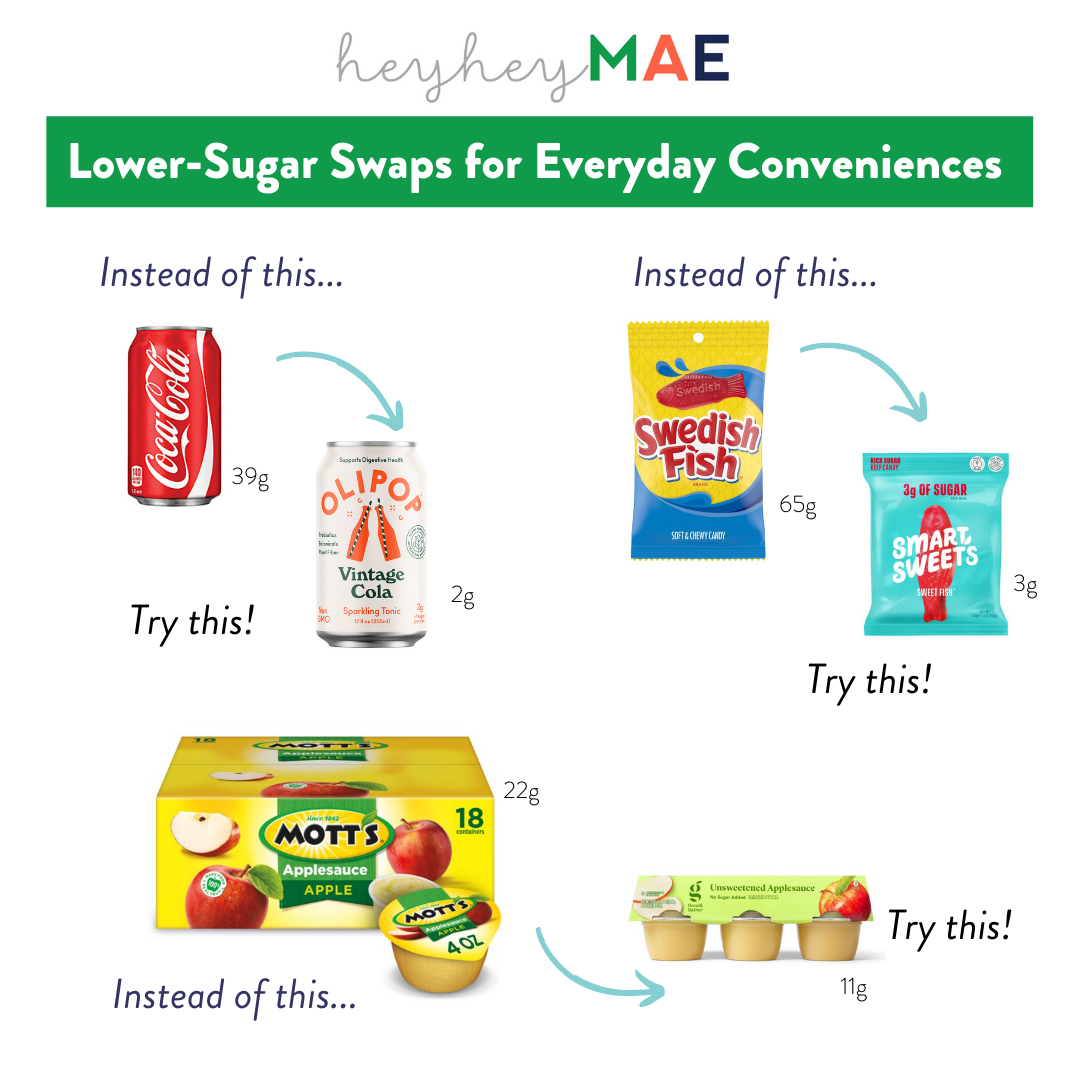Sneaky Sugars and Easy Swaps
I talk a lot about consuming protein, carbohydrates, and fat together to balance blood sugar. All three categories offer us different energy and nutrients to support our blood sugar, body, and health. I do not like to omit any one specific group because I feel that is not sustainable in the long-term (i.e. low fat, low carb, etc.). However, it is so so important that we source our food appropriately to maximize the nutrients we are taking in.
While we do need carbohydrates for the glucose and energy they offer, all carbohydrates are not created equally! We have our nutrient dense carbohydrates like fruits and root vegetables, and natural sweeteners such as honey and maple syrup. Then we have our not-so-supportive carbohydrates that are over-processed, empty calories, and fake sugars. These carbohydrates contribute to blood sugar dysregulation and other health issues down the road. In addition, they never leave us satisfied and typically cause increased cravings as early as a few hours later.
Sugars are sneaky! Did you know there are over 50 different names that they use for sugar in foods? This is why it’s super important to check your ingredients list before purchasing packaged foods. Some of the terms for sugar to look out for:
Agave nectar
Barley malt syrup
Beet sugar
Brown rice syrup
Cane crystals (or cane juice crystals)
Cane sugar
Caramel
Carob syrup
Coconut sugar
Confectioner’s sugar (or powdered sugar)
Corn sweetener
Corn syrup or corn syrup solids
Date sugar
Demerara sugar
Dehydrated cane juice
Dextrose
Fructose
Fruit juice or fruit juice concentrate
Glucose
Golden syrup
High-fructose corn syrup
Honey
Lactose
Maltodextrin
Maltose
Molasses
Muscovado sugar
Palm sugar
Rapadura
Rice syrup
Saccharose
Sorghum
Sugar
Sucrose
Turbinado sugar
Xylose
Typically words ending in ‘ose’ mean sugar. ‘Syrup’ and ‘sweetener’ are also good indicators of a sugar ingredient. Also, many “sugar free” labeled items contain sugar alcohols such as maltitol and sorbitol.
The sugar content in typical packaged foods is astounding. Remember that these foods are essentially void of other nutrients to support all of the sugar they contain. This is going to spike blood sugar and lead to a crash a few hours later.
Entemann’s Chocolate Chip Mini Muffins = 17 g sugar
Naked Berry Blast Smoothie = 23 g sugar
½ cup Blue Bunny vanilla ice cream = 14 g sugar
2 tbsp Nutella = 21 g sugar
Snickers bar = 27 g sugar
Mott’s Applesauce snack cup = 19 g sugar
Dole Diced Pear snack cup = 18 g sugar
Gatorade (20 oz) = 34 g sugar
Vanilla wafers (8 cookies) = 11 g sugar
12 oz Pepsi = 41 g sugar
Vanilla pudding snack cup = 17 g sugar
Oreos (3 cookies) = 14 g sugar
2 Strawberry Pop-tarts = 32 g sugar
Nature Valley granola bar = 10 g sugar
Eggo Cinnamon Toast Waffles = 17 g sugar
What about fruit? The sugar content in fruit varies depending on the fruit. For example apples have about 13 grams of sugar, while strawberries have 6 grams. However, fruit contains other micronutrients, fiber, and antioxidants that are supportive to the body versus the snacks listed above that are empty of nutrients. But, again, when we eat fruit we want to properly pair it with a protein and fat to slow the absorption of the sugar to ensure satiety and a stable blood sugar curve.
Here are some of my favorite snack swaps:
Apple nachos (sliced and cored apple with nut butter, coconut, chia seeds, and dairy-free chocolate chips)
Dates stuffed with goat cheese
Protein smoothie
Celery + peanut butter + raisins
Cucumbers + goat cheese and dill
Carrots + hummus and everything seasoning
For more snack ideas (sweet, savory, dip, and more!) check out my Ultimate Gluten and Dairy-Free Snack Guide HERE.


